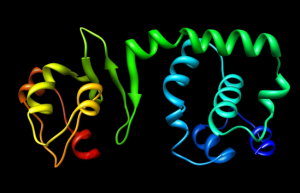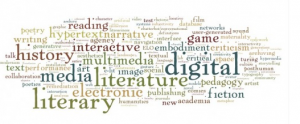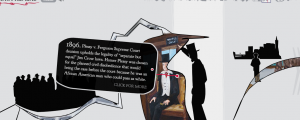The end of the 20th century saw a huge advancement of digital technologies. Hand-written letters, hand-held books, etc., though not totally eliminated from use, were slowly becoming obsolete. The digital and virtual era was approaching as mankind strove in technological evolvements such as computers, cell phones, and the construction of a widely shared virtual network: the World Wide Web. With this tremendous impetus in the time of seemingly incessant new inventions and breakthroughs, the academic disciplines had to majorly adjust, redefine and even reform many of their expressive ways and methods. The digital humanities were created, which relied on computational technology to virtually “copy” the many words written on books to operation system file formats such as doc., pdf., html, and the list goes on, while simultaneously adding elements that were never possible before: videos, augmented pictures and plots etc. As the 21st century beckoned, people become increasingly inventive and constructed a new form of expressionistic art form: electronic literature, or E-Lit. E-Lit was only able to be construed because the transformation of the millennium generated even more “high-tech” computational technology. Software as well as hardware became more and more sophisticated and more intricate software programming software gave rise to complex games, rendering utilities and so on, which E-Lit readily utilized as one of its manifold forms of expressions.
One element that sets E-Lit apart from the digital humanities and other written pieces is that E-Lit itself does not necessarily need verbal expressions. In layman’s terms, E-Lit might have no words in it, but still be a piece of literature. This is a very important aspect to realize before analyzing any electronic literature pieces. Admittedly, most people would think about a written book or anything in alphabetic words or characters when asked to define literature. Our propensity to connect the word literature with written elements actually constraints us from constituting a more comprehensive picture of this sort of art. N. Katherine Hayles, in her book Electronic Literature: What Is It?, specified E-Lit as “digitally born…[and] digital object created on a computer and (usually) meant to be read on a computer”. (Hayles 3) She also indicated that electronic literature pieces might have “no recognizable words, [but might have] important visual components [and] sonic effects…”. (Hayles 4) In class we have extensively discussed the basic elements and inner meanings that are representative of typical E-Literature pieces. Additionally, we have scrutinized many examples of E-Lit pieces on the internet such as MUPS (digital augmentation system), SKIN, City Stories, and the Xenotext Experiment, which “takes programming language and practices into account” (Hayles 28).

The Xenotext Experiment aims to use computational software to code/decode written words into DNA sequences.
One E-Lit piece that I appreciate most was The Knotted Line, which utilizes actual miniature painting created in the 17th-19th century along with a digital timeline to explore the historical relationships between freedom and confinement and the question about how freedom is measured. The general E-Lit was extremely well-constructed. If the program launches successfully, the user will be brought to an all-black colored timeline which shows the “beginning” of American history, or the many confirmed accounts for that matter. The user can then use the mini-map of the timeline, a unique “navigation scheme” (Hayles 7), at the top right corner of the browser to get to the desired time period. The user interface was fraught with game elements. In order to know more about the happenings of a specific famous historical moment, one must move the mouse several times on the black lines of the timeline to virtually “cut open” the timeline, which will subsequently reveal the miniature paintings as well as a very short (usually 10~30) word description of the specific historical time period in America.
In light of Hayles’s interpretation of E-Lit pieces, The Knotted Line fits perfectly into the definition of electronic literature. That is, the piece comprises of as little words as possible, while making up the lack of written elements through stunning visual displays, interesting and explorable game elements, and backdrop sounds to create the ambiance needed to truly appreciate this great workpiece. Through its impressive visual and sound interface, we can clearly see that The Knotted Line uses them dexterously in setting the mood and tone for the things it wants to show. The whole piece, in terms of literary elements, also incorporates numerous themes such as American Slavery history and the fear and isolation of the American society from foreigners and the differently-cultured in the 19th and 20th century (i.e. 1882 Chinese Exclusion Act/ internment camps for Japanese Americans during WWII). Though not extensively clear, the Knotted Line also implies its question of freedom/confinement by telling a historical narrative of the subject matter.
In many aspects, The Knotted Line can be considered as a piece of interactive fiction, though most of its accounts are historically accurate. Hayles claims that “interactive fiction (IF) differs from [other] works…in having stronger game elements….The demarcation between computer games and electronic literature is far from clear…, many works of electronic literature have game elements.” (Hayles 8) The form of expression, that is, using a timeline to document a narrative of freedom and confinement of American history, plus adding game facets such as mouse dragging to it, makes the piece a work of E-Lit that can immensely augment the American history reading experience by giving a graphical and tonal view of slavery and isolationism, thus helping the reader to understand history more thoroughly.
In conclusion, the Knotted Line utilizes various visual and sonic elements, which are highly representative of typical electronic literature pieces, to create a website that is both entertaining, composing of many small yet delightful game elements, and educational, researching and scrutinizing the relations between freedom and confinement while asking questions to make the “reader” think deeper into the subject. As Hayles would have it: Electronic literature “make much fuller use of the multimodal capabilities of the Web”. (Hayles 6)
Sources:
[1] Hayles Katherine N., Electronic Literature: What Is It?, http://eliterature.org/pad/elp.html. Accessed Nov. 3, 2013.
[2] The Knotted Line, Electronic Literature piece, http://knottedline.com/. Accessed Nov. 3, 2013.




